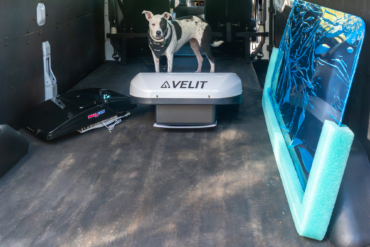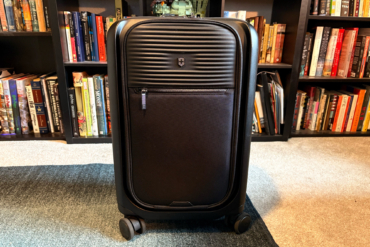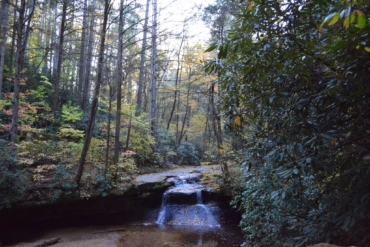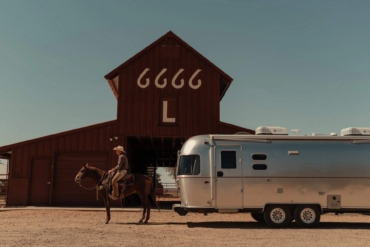My wife and I left our apartment, moved our belongings into a storage unit, and chose to live full-time in a converted school bus.
With no prior knowledge of RVs or van life, it was certainly a nerve-racking leap of faith. Over 365 days (and counting) later, our only regret is that we didn’t do it sooner.
Van life is not always glamorous despite what Instagram suggests. We’ve had our share of middle-of-nowhere breakdowns, expensive repairs, truck-stop showers, noisy Walmart parking lots, and sweaty nights with no A/C. Especially early on, there seemed to be no end to the number of RV technicalities to learn and miscellaneous problems to solve.
And for us, van life didn’t always entail constant travel. Four months of our year in a skoolie were spent in Minneapolis, where we both worked 40 hours a week while living on a friend’s property in our bus. There, we saved enough to spend the other months on the road while I worked remotely part-time.
For us, the pros of having a home on wheels have always outweighed any cons. Here’s what we love most about living in the 200-square-foot hunk of metal we call home.
Living in a School Bus: What We Love
Freedom of the Road
Before hitting the road, we put together a loose travel schedule. We wanted to hit all of the national parks in the 48 states, so we made a few campground reservations in advance at popular parks and during the busy season. Those mandatory stops help us stay on schedule. But for the most part, our plans are flexible. When you’re living life on the road, too much rigidity in your schedule can be limiting and stressful. One of the things we love the most is the freedom it provides.
If we’re digging a particular location, we can stay extra nights. If we hear about a nearby state park or climbing crag from strangers we meet, we can detour a bit to check it out. After a four-night backpacking trip, we can spend a few days in town for some hearty restaurant meals and maybe a movie. We can visit friends and family all over the map. If we have a work deadline, we can post up in a Starbucks or library for the day.

Our mobile home has given us the freedom to see new places, meet new people, and visit cool cities, even while working part-time. We’ve met other van lifers that work full-time, but have chosen to do so remotely so that they can have the freedom to explore the U.S. But even if you can only swing weekend trips due to work or other obligations, the ability to travel easily is a plus of a home on wheels.
New Adventures Out Our Back Door
We used to come home to the same backyard. That wasn’t a terribly bad thing, but this year we’ve loved how different our “backyards” have been. From red rock deserts to high alpine peaks, vast badlands, towering Redwood forests, and ocean beaches, we’ve camped and played among unique and beautiful landscapes.

The ability to step out of our bus and enter a new wilderness is refreshing and exciting. From our home, we can hop on mountain bikes, inflate our packraft, go on a hike, or count shooting stars in the night sky. The United States is so diverse that at every campsite our backyard has new sights to see, animals to spot, and plants to touch. The unique adventure of each day keeps our curiosity and imagination flowing.

Living Simply Yet Comfortably
Though our 38-foot skoolie is big for a recreational vehicle, it’s a significant step down from our plush apartment life. We’ve pared down our possessions (from clothes to shoes, cookware, electronics, etc.) and have learned to live more simply. We shower less, use less electricity (and what we do use is solar-powered), watch less TV, conserve more water, re-wear clothes, cook more, buy fewer things, and spend less on entertainment.
Our life isn’t luxurious, but it’s also not primitive. We’ve loved how comfortable our bus is and how it neatly contains everything we need. Because we spend a lot of time hiking, climbing, and backcountry camping, it’s nice to be able to have a place to come back to that feels like a home.

It’s cute and modern on the inside with windows that allow lots of natural light in. We have a full-sized bed, a large L-shaped couch, a computer monitor that doubles as a TV screen, a dinner table, two-burner stove, fridge, shower, toilet, and even a separate garage for our bikes and camping gear. Every “room” has its own space: There are no tedious slide-outs, and we don’t have to put away the kitchen table so there’s room to fold out our bed.
Although the length of the bus can sometimes be a downside (parking, gas mileage, driving in the city), we’re ultimately glad for it and the comfort it enables.
A Reliable Engine
Our bus is a GMC Bluebird with 126,000 miles on it. Its diesel CAT 3126 engine is built to run for ages if properly maintained. We had a few problems with the engine early on, but it has run like a champ since we fixed those. We’ve driven up and down plenty of mountain passes, on dirt roads, through snow, and through extreme summer heat in the desert. So far, we’ve loved the reliability of the tough diesel engine.
Bus Accessibility
In the beginning, we were worried that where we could drive and park our big bus would be severely limited. But that hasn’t really been a problem for us so far. We’ve loved being able to take it almost anywhere we want. It’s not the best rig for 4×4 roads, but we have taken it on a number of maintained dirt roads for primitive camping.

Overall, parking has been a cinch. We just try to stay out of the thick of it and only take up two facing parking spaces in the back of a lot. Most campgrounds, especially national park campgrounds, are built to accommodate big RVs, so we’ve had very few problems there. It’s not the most fun driving on busy city streets, but we’ve learned how to handle them just fine. The big side mirrors and our backup camera have certainly been handy.
Off-Grid Living & Cheap Utilities
Being able to live off-grid has a ton of perks. It’s allowed us to avoid expensive RV parks and full-service campgrounds in favor of cheaper (or free) places. We can post up anywhere (Walmart, truck stops, rest areas, Forest Service roads, primitive campgrounds) and still have what we need to power our home.

We have no generator and have used RV hookups only twice in nine months of travel. Our three 160-watt solar panels and four 125-amp-hour batteries power our electronics with no problem. We need to fill our 28-gallon propane tank, which fuels our heater and stove, every month and a half. We have a 65-gallon freshwater tank and a 65-gallon gray water tank that typically last us two weeks. Water is our only limiter, but after two weeks of off-grid camping, we’re usually ready for a visit to the city.
We’ve loved that our few utilities are easy and cheap to replenish. Fresh water is almost always free and can be found at most campgrounds or even rest areas or truck stops. We fill up our propane at any LP business or gas station. It typically costs around $40 to fill our tank every month and a half. And that’s it for our utilities! Though we’ve also started counting gasoline as a utility because it’s a chunk of change each time we fill our bus up with diesel.
Exploring on Our Honda Grom
Because our bus is so big and its gas mileage isn’t great, we knew that investing in a small motorcycle was a must. We bought a used 2014 Honda Grom and have loved the little devil. It’s a tiny motorcycle with a 125cc engine that can easily maintain 60 mph with me and my wife aboard. We park our bus for a week or more and shuttle around on the Grom to trailheads, grocery stores, and through cities.

We’ve loved exploring on that thing. It can go 120 miles on a 1-gallon tank, and its front and rear shocks help it handle extremely well on dirt roads. In a year, we’ve put over 5,000 miles on it and have only needed to change the oil and replace the chain. The best part about it, though, is that it can be parked anywhere. Many trailhead parking lots at national parks are often full up, but we never have a problem fitting it in the tiniest of spaces. When not in use, we ramp it up onto a small hitch rack we have on the back of the bus.
Avoiding Winter
We’ve loved avoiding a full-on winter. We planned our route so that we would be south in the winter and north in the summer. In this way, we have successfully skipped a brutal Minnesota winter and have been able to live comfortably throughout the year on the bus. I’ve missed snowboarding and winter biking a bit, but there’s no denying it’s been nice to stay where it’s warm.
Still Having Company Over
Living life on the road doesn’t mean you can’t still be a host to friends and family members. We’ve loved meeting up with people along the way. We’ve hiked trails with friends and then returned to the bus to play board games and eat a meal. People have even slept on our couch or on air mattresses on our floor. It’s been fun to still be hospitable despite the tight quarters.
What We Don’t Love
Life on the road isn’t all roses. While we have no regrets, these are a few bummers that we’ve encountered along the way.
Bad Gas Mileage
Our skoolie gets about 8-10 mpg. It’s not great, but it’s comparable to a Class A RV or a big fifth-wheel. With the miles we’ve put on the bus (11,000 so far), diesel fuel has been a big expense. We’re glad to have the 120mpg Honda Grom to balance things out a bit.
Getting Mail
Another downside is that mail has been a difficult nut to crack. We have the United States Postal Service forwarding our mail to my parents’ address for the year. That’s worked well so far. But we’ve had a number of packages sent to various USPS, UPS, or FedEx locations along our route that we’ve missed because of delays, wrong addresses, or just general confusion.
Middle-of-Nowhere Breakdowns & Expensive Repairs
 When we first bought the bus in Bozeman, Mont., we had a massive breakdown on our way back home to Minnesota. We had to wait to be towed from the interstate to the nearest podunk repair shop in Gillette, Wyo. A motel stay and $2,000 later, we were up and running again and made it home. Since then, we’ve had one other engine breakdown on the road, but thankfully it was a quick and relatively inexpensive repair.
When we first bought the bus in Bozeman, Mont., we had a massive breakdown on our way back home to Minnesota. We had to wait to be towed from the interstate to the nearest podunk repair shop in Gillette, Wyo. A motel stay and $2,000 later, we were up and running again and made it home. Since then, we’ve had one other engine breakdown on the road, but thankfully it was a quick and relatively inexpensive repair.
For a while, we lived in constant fear of the bus breaking down on us. But with time and continued smooth travels, we’ve become more confident in the diesel engine and its longevity.
We’ve taken to heart what a friend once wisely said: “Take care of the bus, and the bus will take care of you.” We’re religious about checking the oil level and taking it in for an oil change every 5,000 miles. When we take it in, we always request a thorough inspection to catch problems early. Even basic services like inspections and oil changes aren’t cheap ($350 or so), but the price of regular maintenance is nothing compared to the price of a big fiasco out in the boonies.
Truck-Stop Showers
Truck-stop showers are never glamorous. When our bus was winterized (meaning our water tanks and pipes were filled with antifreeze), we took a few showers at truck-stops. Some were worse than others. Once, we each set personal records for fastest shower out of fear that the moldy and drippy ceiling was going to collapse on us.
It’s also worth noting that we found showers at other (often nicer) places: community centers, campgrounds, rock climbing gyms, or other workout facilities.
Thankfully, for most of the year, we’ve been able to use the shower in our bus. It’s tight quarters and we try to rinse quickly to conserve water, but it sure beats a roadside truck stop.
Noisy Walmart Parking Lots
Some nights, our backyard isn’t so lovely. In between national parks, we’ll often stop at a Walmart to restock groceries and spend a free night in the parking lot. Most are open 24 hours, which means there’s always commotion. It can get a little funky at around 3 a.m. There’s the typical car-horn or noisy shopping cart, but we’ve also witnessed sketchy meetups, people hot-boxing, drunkards, police lights, and plenty more. To date, we haven’t had anything happen to us directly, but the incessant noise makes it hard to get a full night’s sleep.

Sweaty Nights With No A/C
Our renovated bus has no air conditioning. Many A/C units are 120 volts, so they can only be run by a generator or when hooked up to shore power at an RV park. We have no generator and often opt for primitive camping, so even if we had A/C, we couldn’t power it.
When we visited southern Utah in June and July, it was killer. The temperature gauge in our bus read 110 degrees Fahrenheit and only dipped into the high 80s at night. We lowered all 18 windows, put up some DIY bug screens, ran our Fantastic Fan, and invested in a box fan. Despite all that, we had a number of miserable, sweaty nights.
During the heat of the day, we were always outside hiking or cooling off in the nearest river. Although June and July were rough, the other summer months were spent up north or at high elevation where the nights cooled off considerably.
Bad Cellphone Service
 Lastly, national parks and other public lands aren’t known for their cell service. Though mostly a good thing, poor cell service can make even part-time work difficult. We’ve had to motorcycle miles away for better reception to make important calls and pay for expensive Wi-Fi service ($10 per day!) at a few lodges to send emails. It can be tedious at times, but it’s worth finding a way to get online when it helps pay the bills.
Lastly, national parks and other public lands aren’t known for their cell service. Though mostly a good thing, poor cell service can make even part-time work difficult. We’ve had to motorcycle miles away for better reception to make important calls and pay for expensive Wi-Fi service ($10 per day!) at a few lodges to send emails. It can be tedious at times, but it’s worth finding a way to get online when it helps pay the bills.
All in all, we’ve loved living in our skoolie and wouldn’t trade it for anything else. If you’re on the fence about van life, we hope this post excites you and encourages you to take the leap. There are plenty of advantages to owning a vehicle that can get you out there and double as a home. And if you can’t live on the road full-time, no worries. Be a weekend warrior! Tear up the road and see the world.













